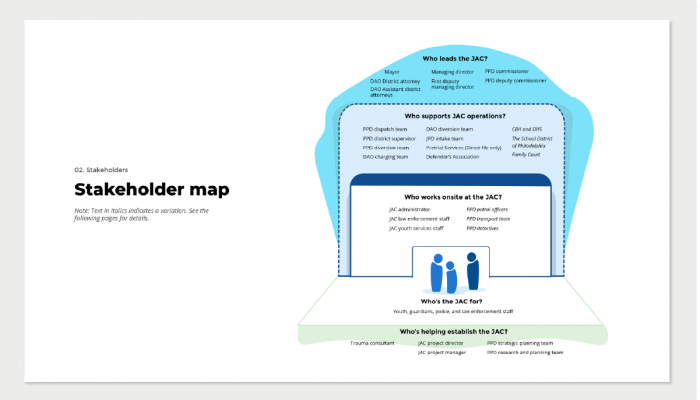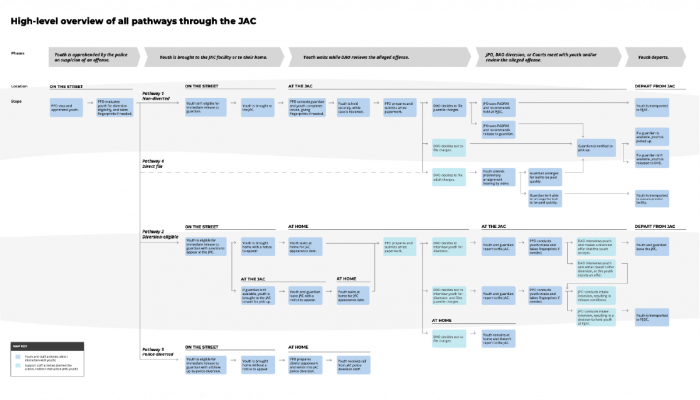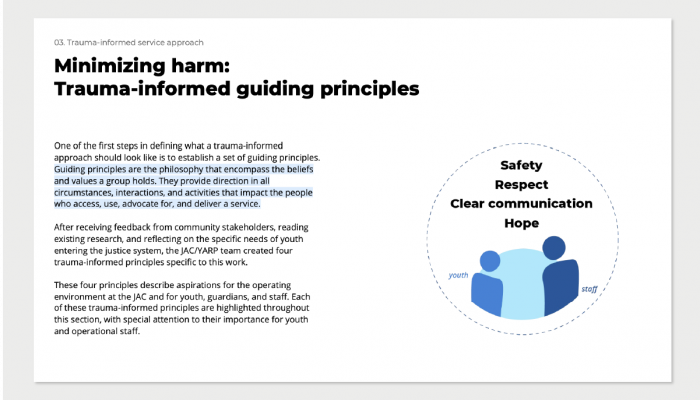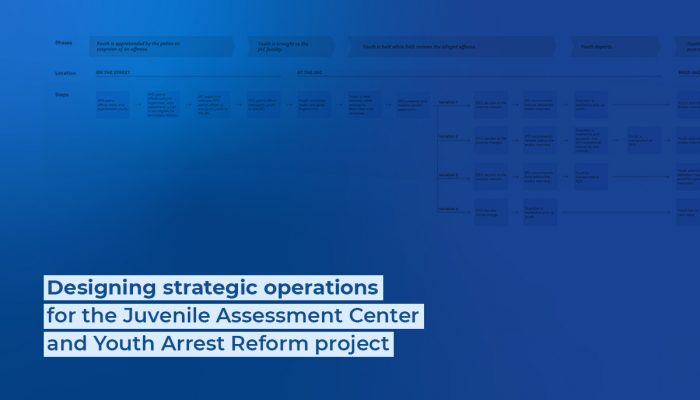This is a case study about a project with the Office of Criminal Justice from February to July 2020.
Project partners
- Main project partner: Office of Criminal Justice within the Managing Director’s Office
- Dr. Meagan Corrado, a trauma-informed care consultant
- Mayor’s Policy Office
- Philadelphia Police Department
Stakeholder participation
11 City staff participated in a series of workshops. Staff represented the following departments:
- Office of the District Attorney
- Philadelphia Police Department
- Department of Public Property
- Mayor’s Policy Office
- Managing Director’s Office
Background
4,000 youth are arrested each year in Philadelphia. When younger people are arrested, regardless of their level of offense, they’re often taken to police stations. At the stations, they’re isolated for many hours in cement cells with minimal communication. In addition, 9 out of 10 youth who enter the Philadelphia justice system have experienced some form of trauma in their lives.
The Juvenile Assessment Center and Youth Arrest Reform Project, mostly funded by the Bloomberg Philanthropies Mayors Challenge, is part of a broader criminal justice reform effort at the City. This effort seeks to improve the experience and outcomes of youth who are interacting with the justice system. The proposed reforms mitigate the trauma youth experience after arrest, increase diversion rates, and improve youth and guardians’ access to resources immediately after arrest. The Juvenile Assessment Center (JAC) will eventually be a physical space dedicated to youth justice.
Goals
The project aimed to:
- Clarify and document the operational decision-making, uncover gaps in thinking, and brainstorm trauma-informed changes to the youth arrest process through a series of conversations with the Office of Criminal Justice and collaborating agencies.
- Demonstrate how reforms will work in practice across stakeholder groups and from street interactions with police officers to releasing young people after processing.
How we worked
Our project followed three fundamental phases of work.
- Mapping key stakeholders: We clarified and documented the organizational ecosystem of the JAC. We outlined which collaborating City agency would own and deliver specific moments in the youth diversion and arrest process.
- Creating operational prototypes: We worked with collaborating agencies to understand what operational decisions had already been made, what protocols couldn’t change, what decisions still needed to be made, and how agencies would work together to deliver a more trauma-sensitive approach to the youth diversion and arrest process.
- Developing a trauma-sensitive strategy: Based on the operational prototypes (e.g., service blueprint maps), we worked with Dr. Meagan Corrado and the Office of Criminal Justice to design a trauma-informed strategy for how the JAC would operate.
What we did
Across all phases of work, we:
- Met with the Office of Criminal Justice on a weekly basis for six months.
- Facilitated over 10 conversations with the Office of Criminal Justice, Dr. Meagan Corrado, Office of the District Attorney, and Philadelphia Police Department to work through operational details.
We developed the following deliverables to help the Office of Criminal Justice set up the JAC site and more forward on policy reforms.
- 21-page stakeholder ecosystem map that outlined the people and organizations who are reforming the juvenile justice system and who support operations at the JAC. This document included:
- An overview of partnering agencies and their roles.
- Agencies that own specific procedures.
- People who work at the JAC.
- People who impact and support JAC operations.
- JAC leadership across City agencies.

A diagram that shows different levels of stakeholders who lead the JAC, support operations, work onsite, and helped establish it.
- Operational prototypes that included two sets of interrelated documents that detailed proposed reforms and operations. They were:
- A 60-page report that provided the overarching strategy for policy reforms and JAC operations.
- 17 service blueprints that showed specific operational pathways for several youth diversion and arrest outcomes.

A diagram that maps different steps and pathways in the youth diversion and arrest process that go through the Juvenile Assessment Center.
- 35-page trauma-informed strategy report that outlined the overarching trauma-informed service strategy of the Juvenile Assessment Center and Youth Arrest Reform project work developed in partnership with Dr. Meagan Corrado. The report included:
- Definitions of trauma.
- The relationship among lived experiences on young people, the justice system, and trauma.
- Guiding principles that support youth-centered trauma-informed practices.
- Next steps for applying trauma-informed principles to on-the-ground operations.

A page from the report introducing guiding principles for a trauma-informed approach at the JAC. They are safety, respect, clear communication, and hope.
Current status
Over the past several years, the City of Philadelphia has shifted prioritizes due to the global COVID-19 pandemic, the resulting budget shortfall, and increased gun violence, among other realities. As a result, the team pivoted this work to focus primarily on policy changes (e.g., youth diversion practices) and youth-centered, trauma-informed training for police officers. As of today, the JAC site hasn’t been built. Rather than a stand-alone location, Youth Support Partners and Master Social Workers will be embedded into a centralized police division with city-wide juvenile arrest processing. In collaboration with Philadelphia’s Georgetown Reducing Racial and Ethnic Disparities capstone team, additional pre-arrest diversion pathways are being developed.
Contact us
We’d love to hear your thoughts about this post. Email us at service.design@phila.gov or join us on Twitter @DesignStudioPHL.




